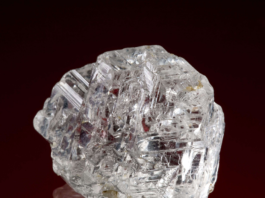Allanite is a complex mineral belonging to the epidote group, which consists of silicate minerals. The mineral was first identified by mineralogist Thomas Allan in 1808, and it was named in his honor. Allanite is known for its variable composition, containing elements such as calcium, cerium, lanthanum, yttrium, iron, aluminum, silicon, and oxygen.

Definition: Allanite is a mineral group within the epidote supergroup, characterized by its black to brownish-black color and often prismatic crystal habit. It has a general formula represented as (Ca,REE,Th)(Al,Fe)3(SiO4)3(OH), with REE indicating rare earth elements. The mineral can exhibit a considerable range of chemical variations due to the substitution of different elements in its crystal structure.
Geological Occurrences: Allanite is commonly found in metamorphic rocks, especially those that have undergone regional metamorphism. It is associated with minerals like garnet, biotite, and feldspar. This mineral can also occur in igneous rocks, such as granite and syenite, particularly in pegmatites where it may form large crystals.
Some notable occurrences of allanite include:
- Norway: Allanite has been found in various locations in Norway, including the Bamble Sector and other areas with significant metamorphic activity.
- USA: Certain regions in the United States, such as Colorado and New York, have reported occurrences of allanite in metamorphic rocks.
- Canada: Allanite has been identified in locations across Canada, including regions in Ontario and Quebec, often associated with granitic rocks.
- Russia: In Russia, allanite has been found in the Ural Mountains and other geological formations.
Distribution: Allanite is distributed worldwide, and its presence has been documented in various countries on nearly every continent. The mineral is part of the broader epidote group, which is known for its occurrence in diverse geological settings. The distribution of allanite is particularly notable in areas with metamorphic activity and granitic rocks.
In addition to its geological significance, allanite has economic importance due to its association with rare earth elements. These elements are crucial in the production of various high-tech products, including electronics and renewable energy technologies. Consequently, the study of allanite and its distribution contributes to both geological research and the understanding of critical mineral resources.
Contents
Mineralogical Properties of Allanite

- Chemical Composition: Allanite has a complex chemical composition, with a general formula (Ca,REE,Th)(Al,Fe)3(SiO4)3(OH). This formula indicates that allanite contains calcium (Ca), rare earth elements (REE), thorium (Th), aluminum (Al), iron (Fe), silicon (Si), and oxygen (O), along with hydroxyl (OH) groups. The specific elements present and their concentrations can vary, leading to a range of compositions within the mineral group.
- Crystal System: Allanite crystallizes in the monoclinic crystal system. Its crystals are typically prismatic, and they may show well-developed faces. The prismatic habit is often observed in metamorphic rocks and pegmatites.
- Color: Allanite commonly appears black to brownish-black. The dark color is characteristic and can help distinguish it from other minerals. However, variations in color may occur due to impurities or differences in chemical composition.
- Luster: The mineral exhibits a vitreous to resinous luster, giving it a shiny appearance. The luster can vary slightly depending on the specific composition of the allanite specimen.
- Hardness: Allanite has a hardness ranging from 5.5 to 6.5 on the Mohs scale. This places it in the mid-range of mineral hardness, making it relatively resistant to scratching.
- Cleavage: The cleavage of allanite is generally poor. It shows indistinct cleavage planes, which means that the mineral does not break along well-defined flat surfaces. Instead, it tends to fracture irregularly.
- Transparency: Allanite is typically translucent to opaque. The dark color and variable transparency are characteristic features, and thin sections of the mineral may reveal some degree of light transmission.
- Streak: The streak of allanite, the color left on a porcelain streak plate when the mineral is scratched against it, is brown. This is consistent with its dark coloration.
- Specific Gravity: The specific gravity of allanite ranges from approximately 3.3 to 4.3. This property helps in distinguishing it from other minerals with different densities.
- Associations: Allanite is often associated with other minerals in metamorphic and igneous rocks. Common companions include garnet, biotite, feldspar, quartz, and other minerals characteristic of the geological environments where allanite is found.
Understanding these mineralogical properties is essential for identifying and classifying allanite specimens in the field of mineralogy and geology.
Formation and Occurrence

Formation of Allanite:
Allanite forms primarily through metamorphic and igneous processes, and its occurrence is closely linked to specific geological environments. The following are the main formation mechanisms:
- Metamorphic Formation: Allanite is commonly associated with regional and contact metamorphism. During regional metamorphism, rocks undergo high temperatures and pressures over large areas, leading to mineral recrystallization and the formation of new minerals. Allanite can crystallize in these conditions, especially in the presence of fluids rich in the necessary elements.
- Igneous Formation: Allanite is also found in certain igneous rocks, particularly in pegmatites. Pegmatites are coarse-grained igneous rocks that form from slow cooling of magma, allowing for the growth of large crystals. Allanite can be one of the minerals that crystallize from these magmas.
- Hydrothermal Processes: Hydrothermal fluids, which are hot water-rich solutions, play a role in the formation of allanite. The circulation of these fluids through rocks can introduce the necessary elements, facilitating the growth of allanite crystals.
Occurrence and Distribution:
- Metamorphic Rocks: Allanite is commonly found in metamorphic rocks such as schist, gneiss, and amphibolite. These rocks result from the transformation of pre-existing rocks under high temperature and pressure conditions. Allanite often occurs alongside other minerals formed during metamorphic processes.
- Igneous Rocks: In igneous rocks, allanite is associated with granitic rocks and, more specifically, with pegmatites. Pegmatites provide a favorable environment for the growth of large crystals, and allanite can be one of the minerals found in these geologic formations.
- Mineral Veins: Allanite can occur in mineral veins, especially those formed by hydrothermal activity. In these settings, fluids circulating through fractures in rocks can deposit minerals like allanite as they cool and react with the surrounding rocks.
- Geographical Distribution: Allanite has been identified in various locations worldwide. Some notable occurrences include regions in Norway, the United States (such as Colorado and New York), Canada (including Ontario and Quebec), and Russia (particularly in the Ural Mountains). The mineral’s distribution is linked to geological processes and the types of rocks present in different regions.
- Association with Rare Earth Elements: Allanite is of interest for its association with rare earth elements (REE). These elements have economic importance due to their use in various high-tech applications, including electronics and renewable energy technologies. As a result, the study of allanite occurrences contributes to our understanding of critical mineral resources.
Overall, the formation and occurrence of allanite are intimately connected to geological processes such as metamorphism, igneous activity, and hydrothermal alteration. The mineral’s presence in specific geological settings contributes to its significance in both scientific research and industrial applications.
Rare Earth Elements (REEs)

The term “Rare Earth Elements” (REEs) refers to a group of 17 chemical elements in the periodic table. Despite their name, these elements are not necessarily rare in the Earth’s crust, but they are often found in low concentrations and are widely dispersed. The rare earth elements include:
- Lanthanides (Atomic Numbers 57-71):
- Lanthanum (La)
- Cerium (Ce)
- Praseodymium (Pr)
- Neodymium (Nd)
- Promethium (Pm)
- Samarium (Sm)
- Europium (Eu)
- Gadolinium (Gd)
- Terbium (Tb)
- Dysprosium (Dy)
- Holmium (Ho)
- Erbium (Er)
- Thulium (Tm)
- Ytterbium (Yb)
- Lutetium (Lu)
- Scandium (Sc) and Yttrium (Y):
- Scandium and yttrium are often included in discussions of REEs due to their similar chemical properties and occurrence in the same mineral deposits.

Significance of Rare Earth Elements:
Rare earth elements play a crucial role in various technological, industrial, and scientific applications. Their unique properties, such as magnetic and luminescent characteristics, make them essential in the following areas:
- Electronics:
- REEs are used in the production of magnets for electric vehicle motors, wind turbines, and various electronic devices.
- Neodymium and praseodymium, in particular, are critical for the development of high-strength magnets.
- Catalysis:
- Some rare earth elements are used as catalysts in petroleum refining and chemical manufacturing processes.
- Luminescence:
- Europium and terbium are essential for the production of phosphors used in LED lighting, fluorescent lamps, and display screens.
- Magnets:
- REEs contribute to the manufacturing of powerful magnets used in speakers, headphones, computer hard drives, and other electronic devices.
- Glass and Ceramics:
- Cerium is used in glass and ceramics for UV absorption, leading to the production of eyewear and windows that protect against ultraviolet radiation.
- Medical Imaging:
- Gadolinium is used in contrast agents for magnetic resonance imaging (MRI) in medical diagnostics.
- Nuclear Energy:
- Some rare earth elements have applications in nuclear energy, particularly in the development of fuel cells and nuclear reactors.
Role of Allanite as a Source of REEs:
Allanite is of significance in the context of rare earth elements as it is one of the minerals that can contain these elements. The mineral often includes cerium, lanthanum, neodymium, and other rare earth elements in its composition. The role of allanite as a source of REEs is noteworthy for the following reasons:
- REE Content:
- Allanite can have a significant concentration of rare earth elements, making it a potential source for these critical minerals.
- Economic Importance:
- Given the growing demand for rare earth elements in various industries, the economic importance of minerals like allanite lies in their potential to contribute to the global supply of REEs.
- Mining and Processing:
- Extracting rare earth elements from minerals like allanite involves mining and subsequent processing methods. These processes are essential for separating and purifying the elements for industrial use.
- Research and Exploration:
- The study of allanite and its occurrence contributes to ongoing research on new sources of rare earth elements. Geological exploration and mineralogical investigations help identify viable deposits that could be economically extracted.
In summary, allanite serves as a potential source of rare earth elements, contributing to the global supply chain for these critical materials. As the demand for REEs continues to rise, understanding the mineralogical properties and occurrences of minerals like allanite becomes crucial for both scientific research and industrial applications.
Allanite’s Uses and Applications

Allanite, due to its composition, which may include rare earth elements (REEs), has various uses and applications in different industries. While it is not as well-known as some other minerals, its unique properties make it valuable in specific contexts. Here are some of the key uses and applications of allanite:
- Source of Rare Earth Elements (REEs):
- One of the primary applications of allanite is its role as a potential source of rare earth elements. REEs are essential in the production of high-tech products, including electronics, magnets, and renewable energy technologies.
- Magnetic Applications:
- Allanite, when it contains specific rare earth elements like neodymium and praseodymium, can be used in the production of powerful magnets. These magnets are crucial for various applications, such as electric vehicle motors, wind turbines, and electronic devices.
- Ceramics and Glass Industry:
- Cerium, one of the rare earth elements found in some allanite specimens, is used in the ceramics and glass industry. It is employed for UV absorption, leading to the production of eyewear and windows that protect against ultraviolet radiation.
- Nuclear Energy:
- Some rare earth elements present in allanite have applications in nuclear energy, including the development of fuel cells and nuclear reactors. These elements contribute to the efficiency and performance of certain components in the nuclear industry.
- Luminescent Materials:
- Allanite, particularly if it contains elements like europium and terbium, can be used in the production of luminescent materials. These materials are employed in the manufacture of LED lighting, fluorescent lamps, and display screens.
- Catalysis in Chemical Processes:
- Certain rare earth elements, if present in allanite, can serve as catalysts in chemical processes, including petroleum refining and the manufacturing of various chemicals.
- Medical Imaging:
- Gadolinium, a rare earth element that may be present in allanite, is used in contrast agents for magnetic resonance imaging (MRI) in medical diagnostics.
- Research and Mineral Collecting:
- Allanite is of interest to mineral collectors and researchers in the field of mineralogy. Its complex crystal structure and variability in composition make it a subject of study for understanding geological processes and mineral formation.
It’s important to note that the economic viability of extracting rare earth elements from allanite depends on factors such as the concentration of REEs in the specific mineral deposit, the cost of extraction, and market demand for these elements.
While allanite may not be as widely recognized as some other minerals, its unique combination of properties and potential rare earth element content contribute to its importance in various industrial sectors and scientific fields.






